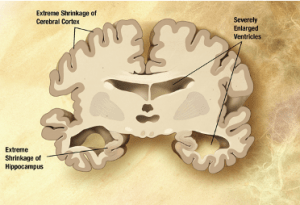Anahita Kodali, Medical Sciences, News, Summer 2020
Figure 1: Another disease caused by aging is Alzheimer’s, characterized by the brain changes shown in this image. Alzheimer’s results in extreme cognitive issues in elderly individuals.
Image Citation: Wikimedia Commons
As people grow older, their bodies change in several ways. For one, older people tend to gain weight. This is due to a variety of reasons, including a slowing metabolism, shrinking muscle mass, increasingly sedentary lifestyle, rising stress levels, and (for women) onset of menopause1. In addition, older people are more at risk for several diseases than their younger counterparts; these diseases include certain cancers, chronic bronchitis, stroke, Alzheimer’s, and Type II Diabetes. Type II Diabetes, which causes eye, heart, and kidney problems, represents a significant issue for Americans: currently, more than 30 million Americans have Type II Diabetes, most of whom are aged 45 or older3.
Some of these issues can be attributed to the aging of the body’s cells. Researchers studying senescent (or aging) cells have found that they have negative, inflammatory effects. T cells, a critical part of the immune system’s adaptive immunity response, also play an important role in natural inflammatory processes in the body. Senescent T cells have been found to accumulate in the adipose tissue of obese individuals, contributing to chronic inflammation and metabolic and heart diseases. Serotherapies have been made to try to eliminate these senescent T cells, but current approaches cannot specifically target T cells and instead eliminate all cell types in senescence, including other immune cells and body cells. This prevents researchers from fully understanding the effect of removal of senescent T cells on health outcomes4.
Recently, a team of researchers at Osaka University in Suita, Japan, wanted to study the impacts of removing senescent T cells in isolation. To do this, the team, led by corresponding author Dr. Hironori Nakagami, created a vaccine that targets the surface protein CD153 on senescent T cells. CD153 is not present in normal T cells, so the vaccine was specific for senescent T cells5.
Once they developed the vaccine, they wanted to study its effects on metabolic processes. They accomplished this by giving mice a high fat diet, mimicking obesity conditions and the metabolic changes that humans undergo when they develop diabetes, including issues with glucose metabolism and insulin tolerance. When the mice were given the vaccine, the number of senescent T cells dropped considerably, showing that the vaccine worked. To confirm that this drop improved glucose metabolism, the team gave the mice glucose, then measured blood glucose levels two hours after consumption; they found that vaccinated mice had much lower levels of glucose than unvaccinated mice, showing that the removal of senescent T cells helped the mice metabolize glucose. The researchers also found that the vaccinated mice had decreased likelihood of insulin resistance5.
These findings will undoubtedly be significant to the future of diabetes treatment. Hopefully, along with other treatments, removal of senescent T cells will help more Americans manage their Type II Diabetes symptoms.
Bibliography
[1] Cheong, T. (n.d.). Middle Age Weight Gain Causes: Menopause, Sedentary Lifestyle and
[2] Older Adults. (n.d.). Retrieved from
https://www.healthypeople.gov/2020/topics-objectives/topic/older-adults
[3] Type 2 Diabetes. (30, May 2019). CDC. Retrieved from https://www.cdc.gov/diabetes/basics/type2.html#:~:text=More%20than%2034%20million%20Americans,adults%20are%20also%20developing%20it.
[4] Osaka University. (2020) A vaccine targeting aged cells mitigates metabolic disorders in obese mice. ScienceDaily. Retrieved from www.sciencedaily.com/releases/2020/06/200630103601.htm
[5] Yoshida, S. et. al. (2020) The CD153 vaccine is a senotherapeutic option for preventing the accumulation of senescent T cells in mice. Nature Communications; 11 (1) DOI: 10.1038/s41467-020-16347-w
